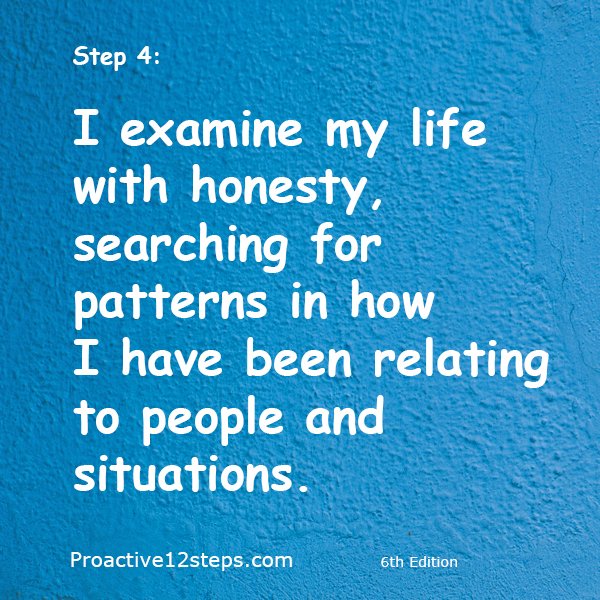
I examine my life with honesty, searching for patterns in how I have been relating to people and situations.
Discussion of Step 4:
At this stage, you are past the denial that you have a serious problem and need to address it. You have understood that you cannot force change. You have started to practice taking a mindful pause to see reality more clearly and calmly. With Step 4, you are now paying attention to your patterns of behavior.
To take an example, let’s say you have been inappropriately rude to somebody. If you think of this as an isolated incident, all you need to do is apologize. Thinking in terms of patterns means taking into consideration different circumstances, different times, different people. You look at the way that several unrelated incidents may have some characteristics in common. Then, you can reflect on what it is that tends to activate you. For instance, what tends to make you angry or to overreact to the situation.
Of course, I’m only using anger as an example. You do this for any patterns that you notice. Bad patterns, such as anger, and good patterns as well. For instance, seeing that you are often generous.
Patterns
Thinking in terms of patterns is an entry point in understanding why you do what you do. Before you can effectively change anything, you have to understand why it happens. Because if you don’t, then you don’t have the tools to change it.
The original Twelve Steps called Step 4 a “fearless” moral inventory. The fearlessness lies in that you accept to face the reality of your fears. Not to be led by them, but to deal with them more effectively.
It isn’t easy to do so. When we face uncomfortable truths, we tend to hunker down, feel defensive, come up with justifications. The only thing that makes this kind of honesty possible is removing the notion of judgment, that is, the potential for blame and shame. Step 4 is about looking at facts. Just facts, as opposed to adding overlays of judgment and blame onto them in such a way that the facts become obscured.
There is a big difference between being in Criminal Court and doing Step 4. In Criminal Court, the rule is for the indicted person to avoid punishment. In Step 4, your goal is to understand better what you’re doing to be who you want to be.
Mindful understanding
We’re talking about mindful understanding. This is different from trying to analyze and to force-feed some logic, some rationality into this. It’s not that human behavior has no logic whatsoever. There is logic, but that is emotional logic. For instance, when you are scared, shadows on the ground will look threatening. When you are happy and safe, behaviors that otherwise might scare you will not be nearly as scary.
As I am introducing the notion of mindful observation, you probably see the link with Step 3. There, we were talking about finding clarity by taking a mindful pause. As of now, barely a step later, you have not yet perfected the art of the mindful pause and the art of finding serenity and patience in looking at yourself. But you’re starting to be more aware of the difference between being in your default mode, between being in a kind of mindless state, and being at least a little more mindful. So now, in Step 4, you’re making use of this growing ability to shift from mindless to a more mindful state. It helps you pay more attention to patterns in your life.
How to do it
To be mindful means, first and foremost, being curious and having the intention to stay as calm as can be, given the circumstances.
In practice, how do you do this?
You focus on a section of your life. For instance, when you were a very young child, when you started going to school, what it was like in high school.
Write about that period of your life the same way as if you were talking to a friend. Prompt yourself to write about friendships. About relationships. About work. About good moments and bad moments. You may start to see some patterns emerging.
If you are doing this with a friend or in a group, I suggest you take turns narrating a section of your life:
In any case, ask yourself what the possible common points between several of these stories might be. It takes curiosity and openness for you to notice patterns. It is OK not to see them right away. It’s OK to spend quite a long time wondering what patterns there might be, if any.
Things will start coming up for you at some point or another, as you cultivate an attitude of openness and compassion.
In other words, the attitude you are cultivating is one of compassion. This builds up an inner sense of safety and trust which makes it more bearable to face reality.